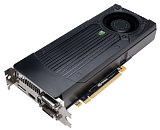Friday, January 17th 2014

NVIDIA Readies GeForce GTX 750 Ti Based on "Maxwell"
NVIDIA's next-generation GPU architecture, codenamed "Maxwell," will debut this February, with the unexpectedly positioned GeForce GTX 750. The card will launch on February 18, to be specific. Maxwell will introduce a host of new features for NVIDIA, beginning with Unified Virtual Memory. The feature lets the GPU and CPU share the same memory. Such a feature is already implemented on the current CUDA, but Maxwell could be designed to reduce overhead involved in getting the thing to work. The next big feature is that Maxwell GPUs will embed a 64-bit ARM CPU core based on NVIDIA's "Project Denver." This CPU core will allow the GPU to reduce dependency on the system's main processor in certain GPGPU scenarios. Pole-vaulting the CPU's authority in certain scenarios could work to improve performance
Getting back to the GeForce GTX 750 Ti, NVIDIA's aim is simple, to see how "Maxwell" performs on the existing, proven 28 nanometer silicon fab process, before scaling it up on the future 20 nm nodes, with bigger chips. Given its name, we expect it to be positioned in between the GTX 760 and the GTX 660 in terms of gaming performance, but we won't be surprised if it falls into an entirely different league with GPGPU. There are no specifications at hand.
Source:
SweClockers
Getting back to the GeForce GTX 750 Ti, NVIDIA's aim is simple, to see how "Maxwell" performs on the existing, proven 28 nanometer silicon fab process, before scaling it up on the future 20 nm nodes, with bigger chips. Given its name, we expect it to be positioned in between the GTX 760 and the GTX 660 in terms of gaming performance, but we won't be surprised if it falls into an entirely different league with GPGPU. There are no specifications at hand.

44 Comments on NVIDIA Readies GeForce GTX 750 Ti Based on "Maxwell"
www.techpowerup.com/gpudb/2462/geforce-gtx-750-ti.html
The GT430 is used to drive my display while the Titans mine :)
And yes, I know this is still a far cry from my 290X' performance (900+ KH/s) at a much lower price, but with each consecutive release cudaminer increases the mining efficiency of CUDA based cards, so don't dismiss Maxwell so easily, chances are Nvidia is going to catch up to AMD when it comes to mining efficiency, and Maxwell could well be the right architecture to do so :)
@15th Warlock, thanks for that. I did not know cudaminer had made such gains as I am already invested in AMD hardware.
If this card can put out ~450k/h for ~ $225 at ~160w it would be a good alternative to amd, comparable to the 7870. If it can do any better than that on any of those three fronts this thing will be quite a special card.
Considering I've just bought 4 280x to mine with and have a setup probably around $2200 or so... 4 750 TIs would be a nice bit of savings if they are priced at 250-300...
I doubt it as its aimed at Gamers and like gk104 compute will be compromised or nvidia are daft
I base my k/h assumption that a mid end, although maxwell card, would not perform better than the top end kepler card.